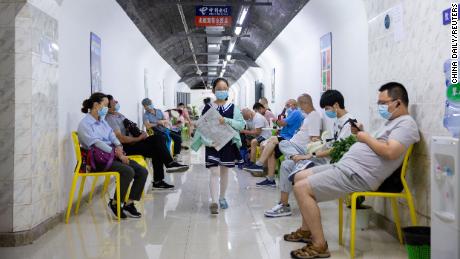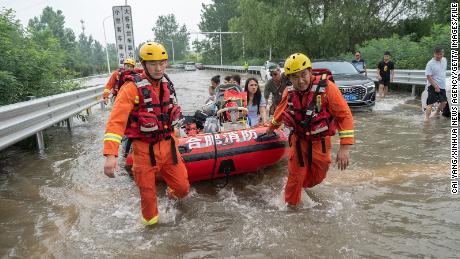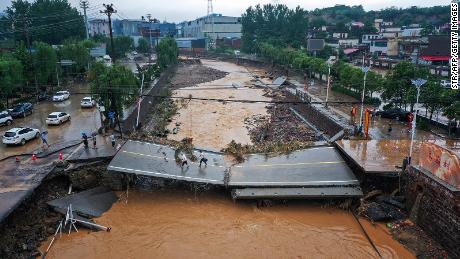
Since summer began, scenes of devastation and misery have been playing out across China as the world’s most populous nation grapples with an unrelenting torrent of extreme weather emergencies.
Scientists have been warning for years that the climate crisis would amplify extreme weather, making it deadlier and more frequent. Now, like much of the world, China is reeling from its impact.
In recent weeks, a total of 71 national weather stations across China have logged temperatures that smashed historical records. Four cities — three in the central province of Hebei and one in Yunnan in the southwest — saw temperatures reaching 44 degrees Celsius (111 Fahrenheit), according to the National Climate Center.
The stifling heat has coincided with a surge in Covid cases, making government mandated mass testing all the more excruciating for residents — including the elderly — who must wait in long lines under the sun. It has also become a dangerous task for health workers who, as part of the government’s ‘zero-Covid’ policy, are required to spend long hours outdoors covered head to toe in airtight PPE equipment as they administer the tests.
Several videos of Covid workers collapsing on the ground from heatstroke have gone viral on social media.
And the worst might be still to come, according to Yao Wenguang, a Ministry of Water Resources official overseeing flood and drought prevention.
Counting the costs
Between 1951 and 2020, China’s annual average surface temperature was rising at a pace of 0.26 degrees Celsius per decade, the report said. Sea levels around China’s coastlines rose faster than the global average from 1980 to 2020, according to the report.
The changing climate can make extreme weather events — such as summer floods, which China has grappled with for centuries — more frequent and intense, said Johnny Chan, an emeritus professor of atmospheric science at the City University of Hong Kong.
A warmer atmosphere can hold more water vapor, which can lead to heavier rainstorms, while global warming can alter atmospheric circulation, which can contribute to extreme weather such as heat waves, Chan said.
“We should be really concerned, because these extreme weather events actually affect the most underprivileged, disadvantaged and vulnerable parts of the population — those in the rural areas, or those who don’t have air conditioning or live in very crowded conditions,” Chan said.
For China, the sheer size of its population and economy means the scale of damage caused by extreme weather events is often massive.
New reality
Meanwhile, many Chinese are only just beginning to realize that climate change will affect them personally.
The Chinese government has promised to bring greenhouse gases to a peak before 2030 and to achieve carbon neutrality by 2060.
Liu Junyan, climate and energy project leader for Greenpeace East Asia, said the Zhengzhou flooding was a wake-up call for the Chinese government and public.
“The central government and local governments started to be aware that climate change is such a enormous threat to society and its sustainable development,” she said, adding that she has noticed more discussions about climate change and extreme weather in China’s traditional and social media.
Since last summer, many Chinese cities have improved their emergency response systems for extreme rainfall. In May, authorities in the southern metropolis of Guangzhou suspended schools, advised residents to work from home, closed construction sites and suspended public transportation in parts of the city following alerts for torrential rains.
“Climate change has already brought serious adverse impacts to China’s natural ecological system, and has continued to spread and penetrate into economy and society,” the government said in its national climate change adaptation strategy.
It vowed to make China a “climate-resilient society” by 2035, by building a nationwide system to monitor and assess climate risks, and by boosting early warning capabilities.
Liu said the policy document is a “very big and ambitious” piece of guidance for local governments, but it lacks details on implementation.
“The impact of climate change can be very localized and its threat to vulnerable communities can be very different from place to place,” she said. “Local governments still need to develop more detailed and tangible plans to implement this grand strategy.”


